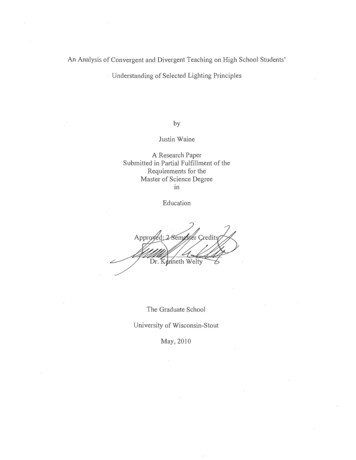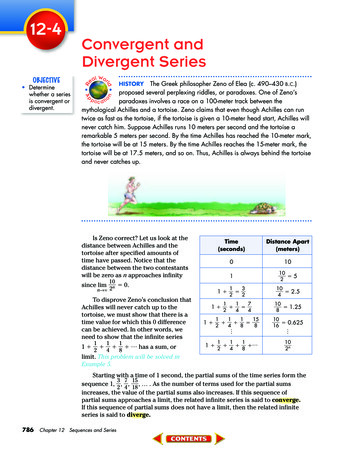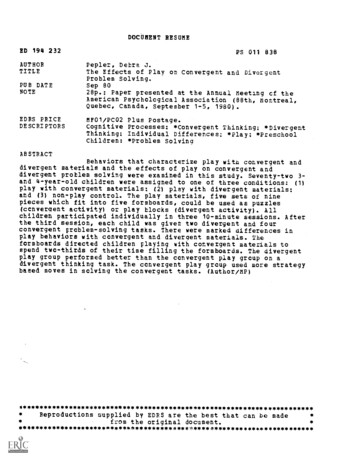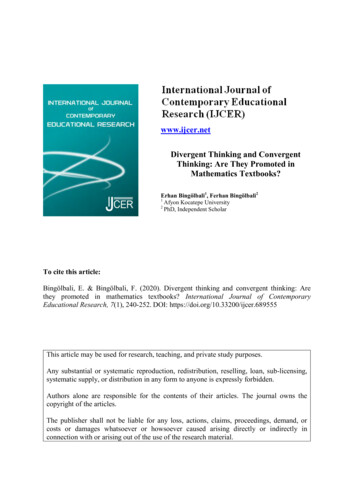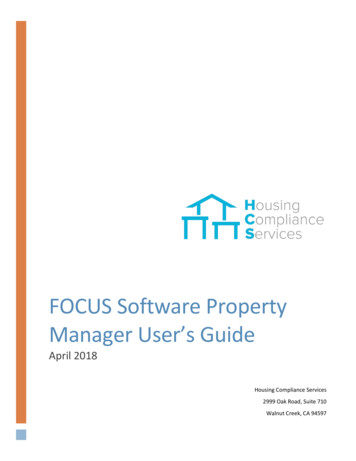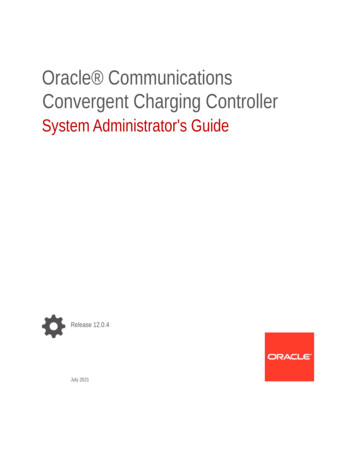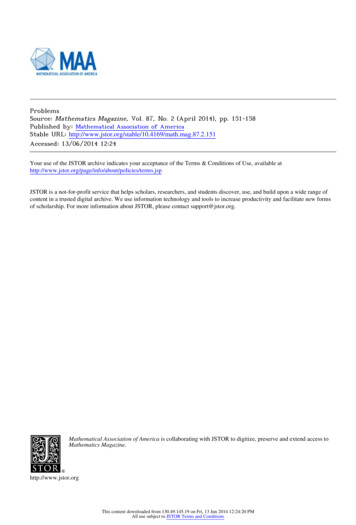
Transcription
Iranian Journal of Language Teaching Research 3(1), (Jan., 2015) 99-11799Content list available at www.urmia.ac.ir/ijltrIranian JournalofLanguage Teaching ResearchUrmia UniversityUsing convergent and divergent tasks to improve writingand language learning motivationHamid Marashi a, *, Parissa Tahan-Shizari baIslamic Azad University – Central Tehran Branch, Iranb IslamicAzad University – North Tehran Branch, IranABSTRACTThis study was an attempt to investigate the comparative impact of convergent and divergent conditiontasks on EFL learners’ writing and motivation. Sixty female intermediate EFL learners were selected fromamong a total number of 90 through their performance on a sample piloted PET and furtherhomogenized in terms of their writing and motivation. Based on the results, the students wererandomly assigned to two experimental groups with 30 participants in each. Both groups underwentthe same amount of teaching time during 18 sessions of treatment which included using divergent tasksfor the first group and convergent tasks for the second. A posttest (the writing section of another samplePET) and Gardener’s Attitude and Motivation Test Battery (used also earlier for the homogenization)were administered at the end of the treatment to both groups and their mean scores on the test werecompared through independent samples t-tests. The results led to the rejection of the first nullhypothesis, thereby demonstrating that the learners in the convergent group benefited significantlymore than those in the divergent group in terms of improving their writing. The second null hypothesiswas not rejected, however, meaning that the two treatments were not significantly different in termsof improving the learners’ motivation.Keywords: convergent/divergent tasks; writing; motivation Urmia University PressARTICLE SUMMARYReceived: 10 Aug. 2014Revised version received: 7 Dec. 2014Accepted: 12 Dec. 2014Available online: 1 Jan. 2015* Corresponding author: Islamic Azad University – Central Tehran Branch, IranEmail address: ahmuya@yahoo.com Urmia University Press
100Marashi & Tahan-Shizari/Using Convergent and IntroductionWritingWriting is an important experience through which individuals acquire the ability to share ideas andfeelings and also persuade other people (White & Ardnt, 1991). “It is a process of generating a textas a communicative bridge between the reader and the writer. It is important to view writing notsolely as the product of the individual, but as a cognitive, social and cultural act” (Weigle, 2002, p.146). Writing has been described as “an act that takes place within a context, that accomplishes aparticular purpose and that is appropriately shaped for its intended audience” (Hamp-Lyons &Kroll, 1997, p. 8). Accordingly, becoming increasingly aware of this necessity, English languageteaching circles are paying further attention to writing (Seidlhofer & Widdowson, 1999) as theability to write well is not a naturally acquired skill; rather, it is usually learned or culturallytransmitted as a set of practices in formal instructional settings or other environments (Brown,2001).Shin (2003) holds that if learning to write in a second or foreign language were simply a matter ofknowing how to write things down in the new code, then teaching writing could be a relatively easytask. Indeed, learning to write even in one’s native language is not simply a matter of writing thingsdown. Indeed, “competent writing is frequently accepted as being the last language skill to beacquired for native speakers of the language as well as for foreign/second language learners”(Hamp-Lyons & Heasly, 2006, p. 81). Perhaps the majority of those who have attempted to puttheir ideas on paper would agree that expressing oneself clearly in writing can be a slow and painfulprocess (Hadley, 2003). This may well be particularly true in the context of ELT as “to apreponderance of EFL learners, nothing is more discouraging than doing a writing task andknowing that it will come under the eyes of the teacher, who will consider it as a source of errorsto be corrected” (Tuan, 2010, p. 81).In ESL/EFL pedagogy, hence, writing needs considerable attention since producing a wellprepared piece requires meticulous consideration. Results of several studies (e.g. Biton &Sivasurbamaniam, 2009; Brown, 2001; Hyland, 2003; Image, 2010; Lindgern & Sullivan, 2003)show that teaching writing through exercises cannot help students select a topic, find references,organize ideas, use supporting evidence, produce outlines, write a draft, revise the draft, anddevelop visual aids. Rather, creating an accurate piece of text calls for attending to many essentialfactors, such as grammaticality of sentences, unity and coherence of the pieces, choice of lexis, andpunctuation (Peasley, Rosaen, & Roth, 1993).Planning a writing course is by no means an easy task and to use Raimes’ (2002, p. 306) analogy,“it resembles walking a minefield as it involves so many choices about where to go next, what isthe best step to take, and what is the best route to the goal”. In an earlier work, Raimes (1983)presented a solid reason why writing should be included as a part of a language teaching syllabusby stating that “the fact that people frequently have to communicate with each other in writing isnot the only reason to include writing as a part of second-language syllabus” (p. 6). Rather, thesignificant reason would be that writing helps students learn better and more since it reinforcestheir knowledge of grammatical structures, idioms, vocabulary, genres, and ways of developing andconnecting ideas to each other. In fact, Raimes goes on to assert that as learners write, “theynecessarily become involved with the new language; the effort to express ideas and the constantuse of eyes, hand, and brain is a unique way to reinforce learning” (p. 3).It is with little surprise then that huge initiatives and endeavors are made to enhance EFL learners’writing competence through designing more effective writing courses. Many such endeavors arebeing materialized within the context of task-based language teaching (TBLT) which has been the
Iranian Journal of Language Teaching Research 3(1), (Jan., 2015) 99-117101subject of extensive inquiry in the last two to three decades (e.g. Ellis, 2003, 2006; Foster & Skehan,1999; Long & Crookes, 1992; Marashi & Dadari, 2012; Nunan, 2005, 2006; Robinson, 2005; Willis,1996).Convergent/Divergent TasksTBLT focuses on the use of authentic language and on asking students to do meaningful activitiesusing the target language with the tasks serving as the core unit of planning and instruction inlanguage teaching (Richards & Rodgers, 2001). There are indeed numerous types of tasks withinTBLT, the application of which is usually determined by interactive conditional factors (Robinson,2005); one such typology is convergent/divergent tasks derived from concepts of knowledgeformation. Convergent tasks are defined as those tasks “that require true justified knowledge,abstract conceptualization, and active experimentation. They allow for collaboration in meaningnegotiation of where a single goal is needed; thus, collaborative work is required” (Skehan, 2001,p. 49). Such tasks should prompt “only one correct answer, allow collaborative work with shortanswers of which are not highly cognitively demanding, and so require no reference making”(Astika, 2004, p. 30). Convergent tasks encourage learners to reach a consensus in order for areasonable solution to be produced (Wegerif, Mercer, & Dawes, 1999). Furthermore, students workinterdependently and need to interact and communicate in a manner that necessitates morenegotiation and interaction (Cropley, 2006).Contrary to convergent tasks, divergent tasks are those that require new significant knowledge andhave various outcome options with possibly more than one goal (Hommel, 2011). “These types oftasks allow independent works which individuals can perform differently according to theircognitive styles and which might lead to different outcomes” (Swan, 2005, p. 382). Questioning indivergent tasks enables students to raise questions with more than one correct answer. In such asituation, there is no correct answer or answers as the possible responses depend on one’s point ofview or experience (Nielsen, Bayard, Pickett, & Simonton, 2008).Duff (1986) states that in convergent condition tasks, pairs of learners are asked to solve a givenproblem together to agree on a justifiable solution to it. While in divergent condition tasks, pairsof learners are asked to cover a broad range of topics and operations and they are assigned differentviewpoints on an issue, and they are asked to defend the given position and refute their partner’swith as many arguments as possible. Duff further elaborates the finding of his study stating thatconvergent tasks (e.g. problem solving) produce more negotiation of meaning than divergent ones(e.g. debating). He concludes that convergent tasks result in more comprehensible input thandivergent tasks but that the latter lead to more output. In addition, divergent tasks produce morewords and greater utterance complexity than convergent tasks.Nunan (1989) also reports the finding of his study: convergent problem-solving tasks promptedsignificant interactional and discourse differences with more and shorter turns than divergentdebating tasks. In another study, Long (1989) reports that convergent tasks result in more turns,questions, and confirmation checks per task than divergent tasks.Reviewing the results of the above studies, one could conclude that there seems to be no specificpattern regarding the definite advantage of divergent and convergent tasks compared to oneanother.
102Marashi & Tahan-Shizari/Using Convergent and MotivationAlongside the ongoing issue of which teaching procedure to adopt in order to enhance learnerintake, equally – if not more important – is the case of learners’ motivation to learn. Ironically,people in need of help often lack the motivation to achieve the things that they want and need inlife (Dörnyei, 2001) as “Motivational deficits can prevent people from seizing opportunities thatwould enable them to lead fulfilling lives” (Spolsky, 2000, p. 112). “These deficits can interfere withpeople’s work productivity and their satisfaction with life. They can cause people to seek alternativebut self-defeating ways to obtain satisfaction” (Gardner, 2001, p. 376).There exists a multitude of definitions regarding motivation with different scholars approachingthis construct from varying angles. Gardner (2001) defines motivation as a “combination of effortplus desire to achieve the goal of learning the language plus favorable attitudes towards learningthe language” (p. 208). Hashimoto (2002) reflects a long tradition when he defines motivation as“the internal status of the organism that lead to the instigation, persistence, energy, and directionof behavior” (p. 429). Ellis (2008) argues that “motivation is defined as the learner’s orientationwith regard to the goal of learning a second language” (p. 208). In Dörneyi’s (2005) opinion,“motivation is as a concept to account for factors within the organism which arouse, maintain, andchannel behavior toward a goal” (p. 303). Finally, Gredler, Broussard, and Garrison (2004) providea somewhat broad definition of motivation: “the attribute that moves us to do or not to dosomething” (p. 106).Motivation is undeniably one of the most important psychological factors that could produceeffective learning and can be considered “without question, the most complex and challengingissue facing teachers” (Scheidecker & Freeman, 1999, p. 116) and is mostly regarded seen as themost noteworthy learner variable since without it, not much is achieved (Cohen & Dörnyei, 2002).“Motivation represents one of the most appealing, yet complex, variables used to explain individualdifferences in language learning” (MacIntyre, MacMaster, & Baker, 2001, p. 462).Motivation in learning a language occurs where EFL learners “find a meaning in learning thatlanguage in the society they live in, where using that language they can express their thoughts,exchange opinions with each other, and therefore feel they would like to learn that languagecontinuously and autonomously” (Vohs, Baumeister, Jean, Twenge, Nelson, & Tice, 2008, p. 885).It is of no surprise then that the literature of ELT is overwhelmed by studies proving thatmotivation bears a significantly positive impact on L2 learning (e.g. Dörnyei; 2005; Ehrman &Oxford, 1990; Gardner, Tremblay, & Masgoret, 1997; Kimura, Nakata, & Okumura, 2001; Oxford& Nyikos, 1989; Oxford & Shearin, 1994; Vohs et al., 2008; Vandergrift, 2005; Watkins, McInerney,Lee, Akande, & Regmi, 2002).It certainly makes sense that motivation would be associated with second language achievementsince language learning requires a long-term time commitment, and motivated individuals wouldbe more likely to devote the time required to language learning (Spolsky, 2000). It is, however,imperative to consider motivation as one of a set of variables in a model of interrelated individualand situational factors which are unique to each language learner (Weiner, 1990).Yet, another prominent feature of motivation is the fact that it shows continuous variability(Dörnyei, 2005). Indeed, “classroom L2 learning motivation is not a static construct as oftenmeasured in a quantitative manner, but a compound and relative phenomenon situated in variousresources and tools in a dynamic classroom context” (Kimura, 2003, p. 78).
Iranian Journal of Language Teaching Research 3(1), (Jan., 2015) 99-117103In line with what has been discussed so far, the purpose of this study was to investigate whetherconvergent and divergent tasks bore a significant effect upon the writing and motivation of EFLlearners and the two following two research questions were stated: Is there any significant difference between the effect of convergent and divergent taskconditions on EFL learners’ writing? Is there any significant difference between the effect of convergent and divergent taskconditions on EFL learners’ motivation?MethodParticipantsA total of 60 female intermediate EFL learners studying at a language school located in Karaj (Iran)participated in this study. These learners were selected based on their performance on a samplePreliminary English Test (PET) administered to a larger sample of 90 students (the sample PEThad been piloted among 30 other female intermediate EFL learners). Next, these 60 participantswere randomly put into two experimental groups prior to the instruction phase; naturally, therewere 30 students in each group while each group consisted of two classes of 15 learners. Hence, atotal of four classes sat in the course. The participants’ age range was between 18 and 26.Furthermore, two teachers (one of the researchers and a colleague of hers who taught the samelevel of classes at the same language school) participated as raters of the writing section of the PETin this study. The two raters enjoyed a significant inter-rater reliability of 0.83.Instrumentations and MaterialsPreliminary English Test (PET)To begin with, the researchers utilized a sample PET piloted beforehand to choose a homogenoussample of participants based on their level of proficiency prior to the study. PET consists of thefour parts of reading and writing (paper 1), listening (paper 2), and speaking (paper 3).As this research was focused on the writing ability of the learners, all the three parts excluding thespeaking section of the PET were administered. Furthermore, the test originally contained 75 itemsbut five items were discarded as a result of the item analysis following the piloting. The reliabilityof the piloting among the 30 students was 0.81 while that of the actual administration for theselection of the 60 participants was 0.87.Rating Scale for the PET Writing PartFor the assessment of parts two and three of the writing section of the sample PET, the two ratersused the PET general mark scheme which is used as a rubric for a summative score. According tothe PET rating scale, the criteria include language range, variety, complexity messagecommunication, grammatical structure, vocabulary, spelling, punctuation, content points, length,and target reader. The maximum overall score would be five.
104Marashi & Tahan-Shizari/Using Convergent and Writing PosttestAfter the treatment process, another sample PET writing paper was administered to both groupsas one of the posttests.Attitude QuestionnaireGardner’s (1985) Attitude and Motivation Test Battery (AMTB – the original English version) wasused in this study at the beginning and at the end of the treatment to check the participants’ attitudein both groups towards the course in general before and after the treatment. This battery includes25 Likert-type items and requires 25 minutes for administration. The test is recognized universallyas being valid with a reliability of around 0.87 (Gardner, Lalonde, Moorcroft, & Evers, 1987;Gardner & Lysynchuk, 1990; Gardner & Macintyre, 1993; Gardner & Tremblay, 1998).Furthermore, the reliability of the AMTB in this study stood at 0.87.Course BookThe participants’ main course book was Passages (Richards & Sandy, 2008) which covers the fourskills of listening, speaking, reading, and writing, while giving systematic attention to grammar andvocabulary. The topic-based syllabus seeks to develop both fluency and accuracy in English andprovides maximum opportunities for personalized discussion that should enhance linguistic andcommunication skills.[ProcedureFollowing the piloting and administration of the sample PET and the formation of the twoexperimental groups, the AMTB was administered to make sure that the learners bore nosignificant difference in terms of their motivation prior to the treatment either.In the treatment process, both experimental groups underwent 18 sessions held twice a week; eachsession lasted 90 minutes and a total of 60 minutes per session was allocated to teaching writing.Throughout the term, four units of the course book were taught to both groups. Each of theseunits comprised five titles for writing. It is worth noting that the researchers used a conglomerationof the ideas and techniques discussed by the following together with their own experience of TBLT:Ellis (2005), Nunn (2006), Skehan (2001), Van der Branden (2006), and Willis and Willis (2007).In the experimental group (N 30) which received convergent tasks and comprised of two classes(with 15 learners in each), the teacher (one of the researchers) divided each of the two classes intosmall groups of five learners. These learners chose their own groups and, in order to be able tocomplete the task focusing on a single outcome, these groups engaged in information exchange.To this end, each group underwent a pre-task stage in which they performed activities to preparethemselves for the task.During the pre-task phase, the groups were asked to think of some words related to the topic (forinstance, TV). They had to write the words down on a piece of paper. Then, the teacher randomly
Iranian Journal of Language Teaching Research 3(1), (Jan., 2015) 99-117105asked the members of each group to say those words (e.g. channel, movie, and film) and the teacherwrote them on the board. After that, she made some sentences within which she inserted the newwords. Next, she listed the new words introduced in the sentences already mentioned in additionto some definitions.The students had to find each appropriate pair. Another pre-task activity for the groups was askinga few questions aimed to activate their background knowledge of the topic (top-down exercise).Examples of these questions were: What do you understand by the term “TV or not TV”? Or how is yourlife going to be without TV? The students had discussed these questions in groups of five before theywrote the text. At the end of the discussion, some of the groups’ answers were randomly invitedto be discussed in the class.The grouping of students remained the same during the pre- and while-task phases. Each groupwas given one or two of the same topics that they had received in pre-task in order to write. Afterthat, each group was asked to recite what they had written. Meanwhile, the teacher helped themcorrect their grammatical errors in this part. The teacher took notes on the common mistakes thestudents made. During the follow-up correction session, the teacher presented the commonmistakes made so that all students could benefit from an analysis of the mistakes made and thereason behind them. This process gave the students clues to the type of error they were making (inwriting) and also allowed them to either correct the mistakes themselves or ask other students toremark on them. They were then asked to write collaboratively once more and choose some newwords and rewrite their texts.In order to cover the post-task phase, the groups were asked to do some tasks such as informationgap, decision making, reasoning task, and problem solving task; subsequently, they wrote theirwriting collaboratively once more. Towards the end, she asked the groups to choose one person asa representative to recite and check their writing. The students used specific forms incorrectly andthe teacher paid close attention to what each group would say without interrupting them. She wrotesome of these errors on the board to be corrected by the students and subsequently, commentedon and corrected some of those wrong forms, wherever necessary.The second experimental group undergoing the divergent condition was divided into small groups.The teacher used an opinion exchange pre-task in which the groups were told to report their viewson the language learning contributions of the preceding tasks, while each interactant had access toall the information needed and supplied it in response to the other individual’s request.In the meantime, each group was asked to work divergently toward different outcomes meaningthat it was not necessary for the groups to reach any agreement. To this end, the groups receivedthe pre-task phase like the previous experimental group to complete the task. During the while taskphase, the students worked in groups of five. Each group was given the same topic in order towrite. Next, they were asked to use the information from the text to report their ideas to theirgroup and teacher through preparing ideas or taking notes before a discussion or, doing a shortwritten assignment. For instance, in such a situation, they were asked to create another title for thetext based on their viewpoints or answer such questions as Can you live without TV? or Which one doyou prefer: swimming in the pool or watching TV? They were asked individually to give reasons to supporttheir ideas and reject their partners’ viewpoints. The teacher walked through the class for furtherhelp.During the post-task phase, the groups were asked to do some tasks such as brainstorming, mindand subject mapping, or opinion exchange tasks and debates. The learners subsequently presentedtheir writing to the whole class individually and the teacher dealt with correcting their written
106Marashi & Tahan-Shizari/Using Convergent and mistakes (grammar, spelling, and vocabulary choice mistakes in written work, mistakes of verbtenses, preposition use, etc.) and vocabulary mistakes (incorrect collocations, idiomatic phraseusage, etc.).Some of the groups’ writings were randomly selected to be corrected by the teacher. The teacherwrote wrong sentences on the board and invited the students to recognize the wrong point withineach sentence. After having discussed each others’ suggestions during this stage, the learners hadthe opportunity to reflect on their writing and chose a useful phrase for each sentence.Finally, the teacher commented on the ungrammaticality of the sentences and wrote the correctform on the board. At the end, each learner individually rewrote her writing again and submitted itto the teacher. Five days after the teaching process was over, the writing posttest and the attitudequestionnaire were administered to both groups.ResultsIn order to test the two hypotheses, the researchers carried out a series of both descriptive andinferential statistical analyses the results of which are elaborated in a chronological order fromparticipant selection to testing the hypotheses.Participant SelectionFollowing the piloting of the sample PET among 30 learners and the actual administration among90 learners to choose the 60 participants (described earlier), the researchers had to ensure that thetwo groups displayed no significant difference at the outset of the study in terms of their writing.Hence, a comparison of the mean scores of the two groups on the writing component of the PEThad to be conducted. The descriptive statistics of the scores on the writing test appear in Table 1below.Table 1Descriptive statistics on the PET writing section at the outsetDivergentPreWritingConvergentPreWritingValid 0As is clear in Table 1, the mean and standard deviation of the two groups stood at 12.25 and 1.38,and 12.28 and 1.57, respectively. The subsequent step was to run an independent samples t-test.With the skewness ratios of the scores of both groups falling within the acceptable range ( 1.96),running this parametric test was legitimized. Table 2 below includes the results of the t-test runbetween the mean scores of the two groups on the writing section of the PET.
Iranian Journal of Language Teaching Research 3(1), (Jan., 2015) 99-117107Table 2Independent samples t-test of the two groups’ writing mean scores on the PET prior to the treatmentLevene’s Testfor Equality ofVariancest-test for Equality of Means95% ConfidenceInterval of tassumedFSig.tDfSig. (2tailed)MeanDifferenceStd. 3831-.800.733.08756.9.931-.0333.3831-.800.733As Table 2 indicates, with the F value of 0.303 at the significance level of 0.585 being greater than0.05, the variance between the two groups was not significantly different. Therefore, theassumption of equal variances applied to this case. The results (t -0.087, p 0.931 0.05) indicatethat there was no significant difference between the writing mean scores of the two groups at theoutset. Hence, the researchers could rest assured that both groups manifested no significantdifference in their writing prior to the treatment and any probable difference at the posttest levelwould be attributed to the effect of the two instructions.The same procedure was conducted with the AMTB (i.e. to ensure that the participants bore nosignificant difference in terms of their motivation at the outset either). Table 3 below shows thedescriptive statistics of the administration of the ATMB prior to the treatment. As is clear in Table3, the mean and standard deviation of the divergent group stood at 303.03 and 26.32, respectively,while those of the convergent group were 303.33 and 22.00, respectively.Table 3Descriptive statistics of the scores on the AMTB prior to the treatmentDivergentPreAMTBConvergentPreAMTBValid 730Again with the skewness ratios of the scores of both groups falling within the acceptable range(Table 3 above), an independent samples t-test was run on the mean scores of the two groups onthe AMTB at the outset.
108Marashi & Tahan-Shizari/Using Convergent and Table 4Independent samples t-test of the two groups’ AMTB mean scores prior to the treatmentLevene’s Test forEquality ofVariancest-test for Equality of Means95% ConfidenceInterval of tassumedFSig.tDfSig. (2tailed)MeanDifferenceStd. .26212.812.23.04856.2.962-.3006.26212.812.24As Table 5 indicates, with the F value of 1.100 at the significance level of 0.299 being greater than0.05, the variance between the two groups was not significantly different. Therefore, the results ofthe t-test with the assumption of homogeneity of the variances were reported here. The results(t -0.48, p 0.962 0.05) indicate that there was no significant difference between the AMTBscores of the two groups at the outset. Hence, the researchers could rest assured that both groupsmanifested no significant difference in their motivation degree prior to the treatment and anyprobable difference at the posttest level would be attributed to the effect of the two instructions.Testing the First Null HypothesisTo test the first null hypothesis raised in this study, that is whether a significant difference existedbetween the two divergent and convergent groups in terms of their writing, the researchers firstreport the descriptive statistics of the writing posttest administration.Table 5Descriptive statistics for the writing posttest in both groupsDivergentConvergentValid .1830As shown in Table 5 above, the mean and standard deviation of the divergent group were 12.97and 1.17, respectively. In the convergent group, however, the mean was 13.82 while the standarddeviation stood at 1.15. In addition, the skewness ratios of the scores of both groups fell withinthe acceptable range (Table 5 above). Hence, an independent samples t-test was run on the meanscores of the two groups on the writing posttest.
Iranian Journal of Language Teaching Research 3(1), (Jan., 2015) 99-117109Table 6Independen
divergent tasks but that the latter lead to more output. In addition, divergent tasks produce more words and greater utterance complexity than convergent tasks. Nunan (1989) also reports the finding of his study: convergent problem-solving tasks prompted significant interactional and discourse differences with more and shorter turns than divergent
